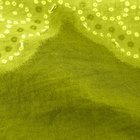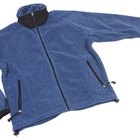
Since bathrobes are made to be absorbent, they can also be dyed. The majority of bathrobes are made out of terry cloth, which is a cotton-based material. If the robe is made from wool or silk, the process is slightly different. The process itself is not particularly difficult or time consuming, but care does need to be taken to ensure an even finish to the dye.
Cotton
Wash the bathrobe to remove any dirt or grease that will stop the dye from taking hold of the fabric.
Mix water and salt in a large container so the bathrobe can be fully submerged with room to spare. The salt is not always necessary, so consult manufacturer's guidelines.
Combine the dye and hot water in a separate cup and mix in with the water and salt. For mixing guidelines, consult the dye manufacturer's instructions. As a basic rule, the deeper and richer the color required, the more dye is needed.
Submerge the bathrobe in the dyeing tub and leave for 20 minutes, stirring regularly with a paddle or stick.
Add a mixture of soda ash and water over the course of 15 minutes ensuring the soda does not come into contact with the bathrobe before it dissolves. Move the robe to one side of the tub with the paddle and then pour in the ash.
Remove excess dye by washing the bathrobe in cold water. Leave to dry, then wash in a washing machine on a cold setting.
Silk and Wool
Mix the dye with a small amount of water to create a paste and then add a cup of hot water and stir well.
Pour this mixture into a container that can be heated up and add salt as per dye manufacturer's recommendations.
Add the silk or wool garment and warm water so it is covered by the liquid with room to spare.
Put the container on the stove and bring up to a simmer and leave for 10 minutes, stirring regularly.
Pour 2/3 cup of white vinegar, mix in well and leave to simmer for 10 minutes while continuing to stir occasionally.
Take out the garment and wash with warm water and an after-dye agent until the water runs clear. Slowly reduce the temperature of the cleaning water to room temperature so the fabric is not damaged.
Related Articles

How to Dye a Swimsuit

Instructions for Dylon Permanent Fabric ...

How to Dye Fabric Using Kool-Aid & ...

How to Dye Tulle

How to Dye Leotards

Can Modal Be Dyed?

Can You Dye Khakis Black?

How to Bleach Satin

How to Dye Cotton Pants

How to Dye Faded Clothes

How to Dye a Satin Dress

How to Dye Polyester Fabric

How to Dye Faded Black Dress Pants

How to Dye a Fleece Jacket

How to Dye Fabric Using a Front-Loading ...

How to Dye Tulle

How to Redye a Shoe

How to Dye a Cotton Blazer

How to Dye a Linen Dress

How to Soak Tie-Dye in Baking Soda
References
Photo Credits
Creatas Images/Creatas/Getty Images